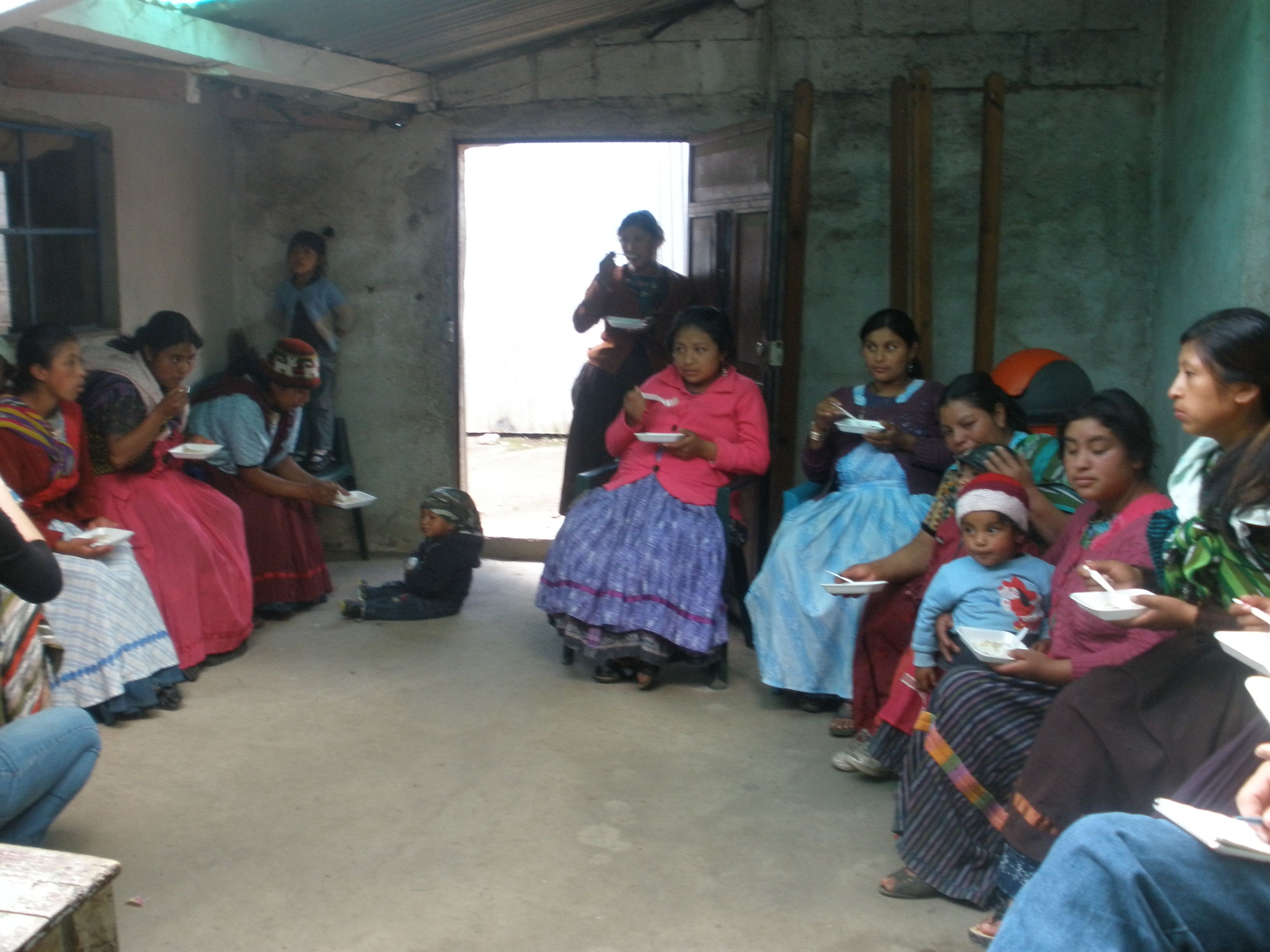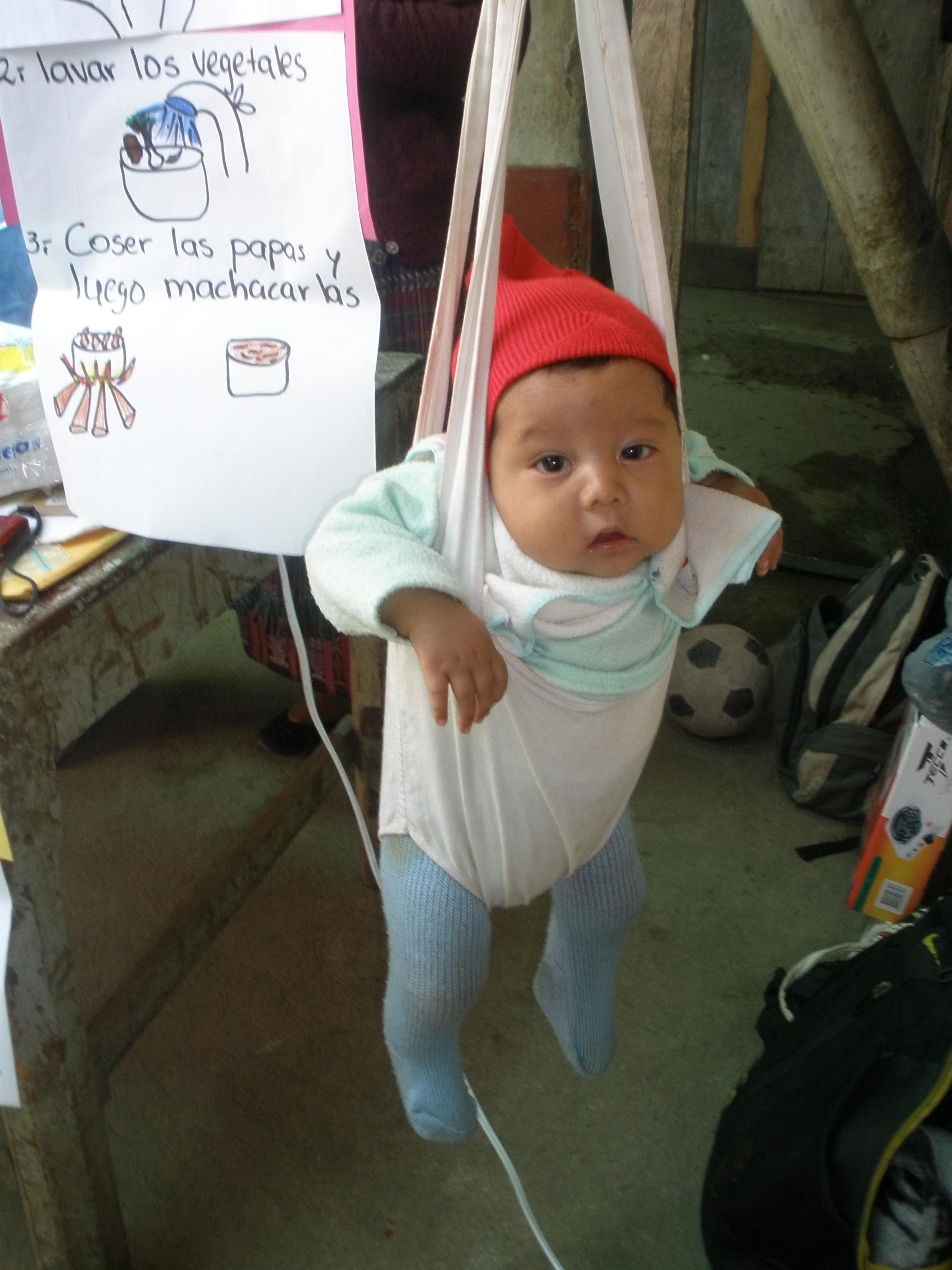Chuicavioc, Guatemala: Janet Coyoy focused intensely on the cooking demonstration, taking mental notes on how to make cream of potato soup thick with vitamins and nutrients. It was only when another mother placed a baby in the nearby weighing contraption that her eyes shifted from stove to scale.
Janet herself was seven months pregnant with her first child and she was well aware of Guatemala’s malnutrition woes — nearly half of the country’s children under five are chronically malnourished, the worst rate in the Americas, leading to stunting and other health problems that can cost Guatemala more than 10 percent of its GDP. Watching the infants hang in a cloth sling attached to a hook at the bottom of a scale — and seeing the meager numbers — Janet became more determined to deliver and raise a healthy child. Her baby, she hoped, would beat the odds.
“We see a lot of malnutrition here, not just the children but the mothers as well,” Janet, 23, said. “As the baby grows inside, it’s not getting enough vitamins and nutrients. I now know that this is important. I need to eat better, for myself and the baby.”
That is what brought her to this community meeting place, inside a warren of brick homes and shops, to learn about potato soup. Susy Menchu Tacam and Isabela Menchu Mejia, nutrition instructors for a non-profit health organization called Primeros Pasos (First Steps), stirred a pot of potatoes and added milk, onions, garlic and a packaged mix of vegetable protein that has the texture of ground beef. The appetizing smell of fried onions and garlic filled the room, beckoning women outside to join the gathering.
“It is important to understand the mix of the ingredients and how they help us,” Isabela said as she stirred. “They gives us calcium, vitamins, protein, carbohydrates."
“This is a meal that has a lot of vitamins and nutrients and is very good for you and your children,” Susy added. “We can make this for lunch or dinner and eat it with tortillas or tamales. And it is also good made with broccoli or spinach.”
Janet had occasionally eaten potatoes, but she had never combined them with other ingredients to make a whole meal. This recipe was a revelation.
“I like this,” she said as bowls of the soup were passed around to the 20 women and children who gathered for the lesson. “I’ll try this at home,” she promised Susy. Then she added, “Last week I made your carrot recipe. It was good. Something new.”
The cooking instructions are a simple, yet vital, element of Primeros Pasos’ nutritional recuperation project, which aims to conquer malnutrition among children and pregnant women in the rural Maya communities of the Palajunoj Valley, beneath the dormant Santa Maria volcano. In Guatemala’s Maya communities, the stunting rate of children under five often exceeds the national rate; this perpetuates poverty, as stunted children likely won’t achieve their physical or mental potential, resulting in diminished work productivity in adulthood and a higher chance of dying from infectious diseases.
The nutritional recuperation project began in 2012, with the immediate focus on the treatment and recovery of underweight and under-developing children in 25 families. By the end of the year, all of the children in the program — each under five years of age — recovered their weight and grew to sizes considered normal for their age.
This year, Primeros Pasos expanded the project and focused on women and children in the 1,000 days time frame — the days of a woman’s pregnancy through the second birthday of the child, when proper nutrition is critical for the development of the infant’s body and brain. The mothers gather once a week in their villages to receive nutrition, cooking and hygiene education.
In Chuicavioc, as the mothers sampled the cream of potato soup, they talked excitedly about the results of the program so far. Maria Delfina Camacho, who gave birth to Jose Alexander in May, beamed as she recalled his weight. “He was born healthy,” she said, nearly seven pounds. And at one month, he weighed “more than a four-month-old” who had been on the scale before her son.
Luisa Rufina Gomez similarly marveled at her son Jose, who has gained more than two pounds every month since April. When the program started, he was five months old and decidedly underweight. Now, at 10 months, he was just above the “average” line on the growth charts Susy maintains on her laptop.
Janet, awaiting her first child, noted the progress. “I’ve seen a difference with the children in our group,” she said. “They are chubbier, growing more, they have more energy.”
The day before the potato cream soup lesson, Susy stood before a dozen mothers and mothers-to-be in the village of Llanos del Pinal. She attached colorful cloth cutout shapes of food to a cardboard bowl taped to a wall of a community health center. She told the women that food from all the various categories — grains, proteins, fruit, vegetables, dairy — are needed for a healthy diet, one diversified away from the traditional corn-centric meals. “Your children don’t need just tortillas,” she said, “they must have tortillas with beans, vegetable stew, some meat when you can afford it.”
Susy asked the women to put the food shapes into the bowl themselves.
“Where do you get iron?” she asked.
“Meat, beans, vegetables,” replied Maria Estella, 24, who occupied two places in the 1,000 days: she was both pregnant with a child due any day and weaning an 18-month-old daughter.
“Why do we need to consume iron?” Susy followed.
“So we don’t get anemic,” said Yolanda Chiche Perez, 28, who took notes while balancing her 10-month-old son on her lap.
Other women applauded the answers.
“You must put a piece of cotton in your ears,” said Susy, laughing, “so everything you hear today won’t leave you tomorrow.”
“Si,” Yolanda agreed. “We now know the food to put in the bowl, but often we can’t afford it.” It is a dilemma shared by poor women in the 1,000 days across the world.
In Guatemala, the paradox is particularly haunting. During the rainy season, food grows everywhere. Maize is the most ubiquitous, growing up and down the hills and blanketing the valley floors. In between the maize patches grow cabbage, beans, broccoli, carrots, onions and an assortment of other vegetables. Much of that, though, is destined for markets in urban areas or abroad. The women of the Palajunoj Valley, who mainly toil as day-laborers in the fields, are hard-pressed to afford the vegetables on a regular basis.
After the cooking lesson, Janet walked back to her home on the side of a hill, surrounded by her family’s fields. The maize is growing to the edge of her house. She showed off patches of squash, cauliflower and chard. With the knowledge from the Primeros Pasos classes, Janet now lobbied her parents to store more of their upcoming harvest at home for the family to eat rather than haul most everything to the markets.
She has a powerful pitch for them: “We must do it for your healthy grandchild.”





